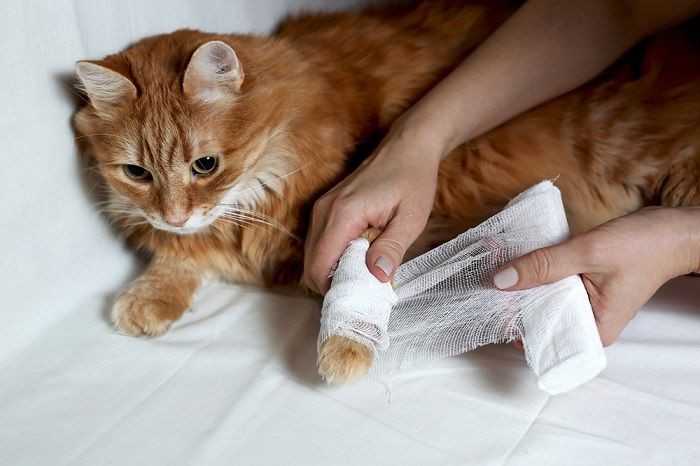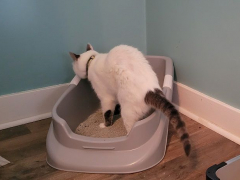
Having a cat brings many joys but sometimes it also brings more worries. This is especially true when you have a wounded cat.
A cat might get a scrape or abrasion simply from rubbing against a hard or rough surface. Or they might get into a catfight and end up with scratches and bite wounds. Some wounds that are only minor can be treated at home while others require veterinary attention. Read on to find out when to clean a cat wound at home, and how to provide first aid where home care would be appropriate.
Types Of Wounds That Can Be Managed At Home

Some cat wounds require a cat to wear a cone to prevent them from licking the wound and causing an infection.
Small, superficial cuts and scrapes that don’t extend through the full thickness of skin and are only bleeding superficially can be tended to at home. If you find a wound on your cat, carefully look for wounds elsewhere on their body.
It’s best not to delay veterinary care for more serious wounds or injuries. These include:
- Bite/puncture wounds: Your cat might have come gotten some bite wounds from fighting with another cat. These may appear small initially but it’s important that you contact your veterinarian if you notice these. Animals’ teeth are full of bacteria and your veterinarian will prescribe a course of antibiotics.
- Abscesses: Cats most commonly get abscesses from cat bite wounds. You might not notice that your cat has been bitten until a large, uncomfortable swelling appears. These cannot be managed at home.
- Large or deep wounds: Wounds that cover a large surface area or expose tissue underlying the skin need to be treated by a veterinarian, who will advise whether sutures are needed.
- Wounds that won’t stop bleeding or that are bleeding a lot: If your cat is bleeding, apply pressure to the wound with a gauze swab or clean cloth for 10-15 minutes. If you can’t stop the bleeding, contact your veterinarian.
Also Read: What Can You Give A Cat For Pain? 6 Vet-Recommended Options
Signs Of An Infected Wound

Infected wounds can be serious and should be seen by a veterinarian right away.
All wounds should be checked carefully for signs of infection, whether they have been managed at home or at the veterinary hospital. If your cat’s wound is infected, you might notice:
- Swelling and heat around the wound
- Redness and inflammation of the skin
- Pus/discharge
- Pain and discomfort
- Foul smelling odor
- Lethargy
You must contact your veterinarian if your cat develops any of these signs.
Also Read: Why Does My Cat Not Like To Be Held?
How To Clean A Cat’s Wound

With a few simple tools and know-how, you can clean your cat’s minor scrapes and cuts at home.
First, you will need to gather your supplies to treat a wounded cat. It’s best to have everything you need in hand before you start. These supplies include:
- Saline solution: This can be bought from your local pharmacy. You can also make your own by putting 1 teaspoon of salt in 500ml of water and boiling for 10 to 15 minutes. Allow it to cool before using it.
- Diluted antiseptic solution. As an alternative to saline, you can use an antiseptic, such as chlorhexidine or povidone-iodine. These must be diluted as they will cause irritation if used in their pure forms. Follow the instructions on the label for an appropriate dilution. Otherwise, mix 1 part chlorhexidine or povidone-iodine with 10 parts warm water. Though some recommend hydrogen peroxide, do not use this as it will damage healthy tissue.
- Syringe (without the needle)
- Sterile gauze swabs or cotton wool balls/pads
Next, you will need to clean a cat wound by following these steps:
- Restrain your cat. Be mindful that they will be in at least some discomfort. You might find it easier to have someone help hold them. Wrapping a towel around your cat will make restraint easier. This ‘kitty burrito’ also helps to calm them, which will allow you to assess their wound better. If your cat becomes very stressed and anxious, don’t continue any further.
- Clip away the fur surrounding the wound. If you have a pair of pet clippers on hand, use them to carefully remove the fur around the wound. If you don’t feel comfortable doing so, you can skip this step. It’s always better to be safe than sorry – the last thing you want to do is to cause further injury to your cat. Don’t be tempted to use scissors either as you’ll risk accidentally cutting your cat’s delicate skin.
- By clipping away the fur around the wound, you can better assess the extent of the wound and check for any swelling, inflammation, or bruising. It might reveal other wounds that were hidden away. Clipping also prevents any matting or contamination. Make sure you don’t clip over the wound as this will cause irritation and discomfort. Consider placing a gauze swab on top of the wound and then clip around the edges so that the clippers don’t accidentally catch the wound.
- Flush the wound. The key to cleaning a wound is to use a large volume of the cleaning solution and flush the wound again and again. This lavage process will wash away any dirt and debris, as well as decontaminate the wound. Draw up the solution with a syringe (make sure to remove the needle if there is one). Then, applying moderately firm pressure to the syringe plunger, direct the solution over the wound. Don’t forget to flush around the edges of the wound as well.
- You can repeat this for as long as your cat will tolerate it. If you don’t have a syringe, you can soak some cotton wool balls or pads in the cleaning solution. Then clean the wound by wiping away from the center of the wound. Clean cotton wool balls or pads that have been freshly soaked should be used for each wiping motion so that any dirt or bacteria doesn’t get reintroduced to the wound.
- Dry the wound as thoroughly as possible. Gently dab the wound with gauze swabs to dry. Don’t rub the wound back and forth.
- Prevent your cat from licking the wound. After all that work to clean the wound, it’s important to prevent your cat from licking it so that they don’t introduce bacteria and disrupt healing. It is best to put on an Elizabethan collar (you might know them as an e-collar or ‘cone of shame’). An appropriately fitting one will stop your cat from reaching around and having access to the wound. Keep this on them at all times while the wound heals. It shouldn’t affect their daily routine of eating, drinking, and using their litter box.
Also Read: The 7 Best Cat Collars
Conclusion

Whether serious or minor, cats sometimes get wounded, just like people.
Accidents can unfortunately happen. Outdoor cats are more at risk of getting wounded or injured. But indoor cats can get cuts and scrapes as well so it’s always a good idea to have a first aid kit on hand for managing minor wounds.
Also Read: How To Keep Your Cat From Jumping After Surgery
Frequently Asked Questions
What can I use to clean my cat's wounds?
If your cat has a minor wound, you can clean it at home with saline solution or a dilute antiseptic solution. Saline solution can be bought over the counter from pharmacies or you can make your own salt water solution. Chlorhexidine and povidone-iodine are suitable antiseptics for wound cleaning but an appropriate dilution should be used.
Can a cat's wound heal on its own?
Small, superficial wounds usually heal by themselves without intervention. It’s important the wound is kept clean and dry. Your cat should be prevented from licking the wound so as not to delay the healing process. It should take a few days to a week to heal.
What does an infected cat wound look like?
If your cat’s wound becomes infected, some of the signs you might notice include swelling, inflammation of the skin, pus/discharge, a foul odor, and pain.
-
Winkler, K (2019). Emergency Medicine and Critical Care: Initial Wound Management in Animals. MSD Veterinary Manual. Retrieved 13 October 2022.








Can u put antibiotic salve on a cats wound
Yes! As long as you use a cat-specific product that’s safe for your cat to lick off, antibiotic wound treatments can be a good idea. You can learn more in our article on the safety of Neosporin for cats.
My cat came home w her foot like this can I use normal sailing on her open wound to clean it
Hi Hood, saline is a great start for cleaning a wound but it wouldn’t hurt to treat it with an antiseptic like Neosporin as well. If the wound is deep, however, I’d recommend taking your cat to the vet for treatment.